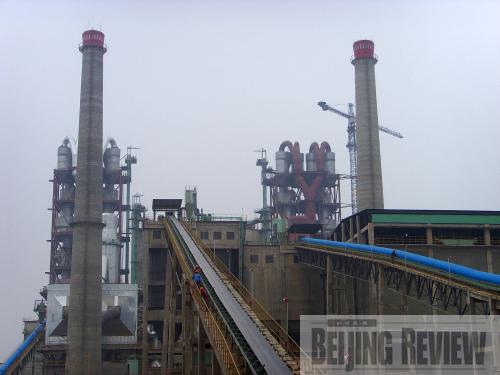|
 |
|
COOLING CEMENT: Anhui CONCH Cement Co. Ltd. operates at full capacity as it benefits from the investment spree prompted by infrastructure and real estate projects (CNSPHOTO) |
Policymakers are looking to build a concrete wall around the cement-making industry as they seek to solidify the fluid cement market and cut excessive production.
On September 7, the Ministry of Industry and Information Technology (MIIT) issued a draft circular, raising requirements for enterprises that plan to line up cement-making operations. The draft regulation, which was open to public comments until September 20, will be finalized by year's end.
Clampdown on excessive capacity
There is no doubt that policymakers want to cool down the overheating cement industry saddled with overcapacity, said He Guowen, a senior analyst with the Beijing-based Sinolink Securities Co. Ltd., in a report. Seldom before has the government enacted such detailed and concrete measures for the sector, he added.
Indeed, the problem of overcapacity has been a protracted ailment bearing down on Chinese cement makers. By the end of 2009, cement capacity nationwide totaled 2.8 billion tons, but the maximum demand was estimated at only around 1.8 billion tons, said Lu Guixin, a senior official with the MIIT, at the third Zhejiang Cement Business Conference held on September 27 in Hangzhou, capital city of Zhejiang Province.
Analysts believe the root cause of the overcapacity surely lies in burning-hot investments. The buoyancy of the real estate market injected steam into the real economy, also delivering a heavy boost to the numerous cement makers and triggering vibrant investments in the sector.
Recognizing the pitfalls of overcapacity, the Central Government stepped up a strict control over the cement sector as early as 2002, and closed a large number of small mills in order to strengthen the fragmented industry.
The task, however, appears to be easier said than done, especially after the financial crisis that has plagued global markets for the last year put the onus on investments as a source of growth. The infrastructure-weighted government stimulus package kicked off a spending spree geared toward highways, airports, bridges and railways, stimulating demand for cement. This has helped prompt an 11-month upward trend in domestic cement prices, adding fuel to the fires of investment in the sector.
According to the data from the National Bureau of Statistics, investments in fixed assets in the cement industry from January to August this year exceeded 100 billion yuan ($14.6 billion), representing an increase of around 66 percent year on year. The increase in investment was much faster than that of most other industrial sectors.
Besides this, the cement output nationwide in the first eight months grew by a robust 17 percent from last year's same period, according to the China Cement Association. In May and June alone, the number of newly opened cement production lines totaled a dizzying 23, with 13 of them having a daily capacity of 4,000 tons and above, said the association.
Worse still, the new investments will lead to a wider expansion in production capacities in the next two years, exacerbating the overcapacity conundrum, said analysts.
Aside from alleviating the cement market saturation, the regulation has another obvious purpose—to discard backward capacities and press ahead with advanced technologies.
Nowadays there are two prevalent cement-making methods in China: the outdated polluting shaft kiln technology and the advanced environmentally friendly precalcining technology.
Data from Chinacements.com, a leading cement trade website, showed that 37 percent of China's cement is now made using outdated methods. But according to the draft regulation, shaft kiln cement mills will no longer be approved to operate.
By implementing the new policy, the MIIT is reportedly gearing up to remove all shaft kiln-produced cement off the market in three years. The end result would be a cut of nearly 600 million tons of capacity from more than 3,000 domestic enterprises.
| 